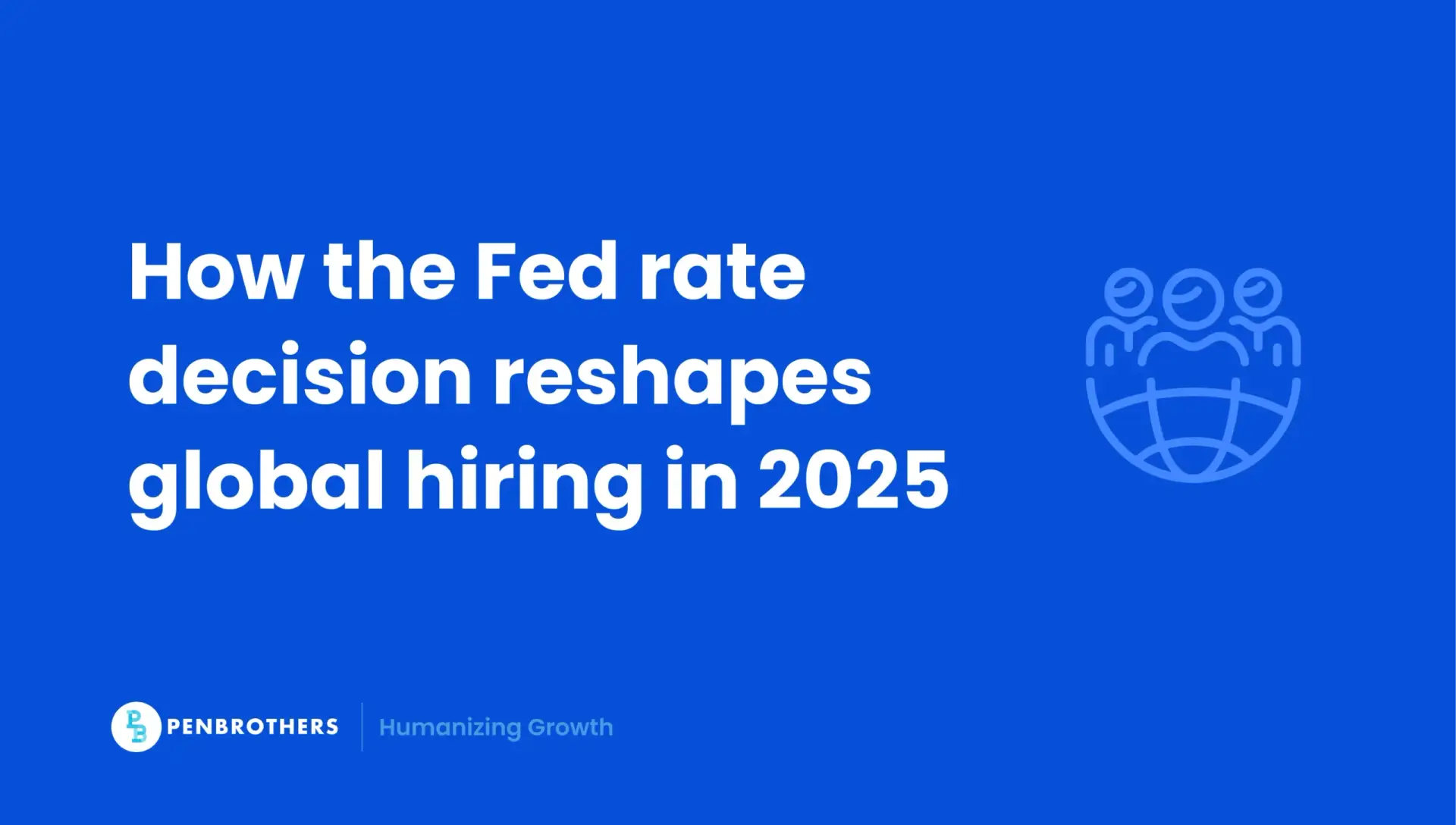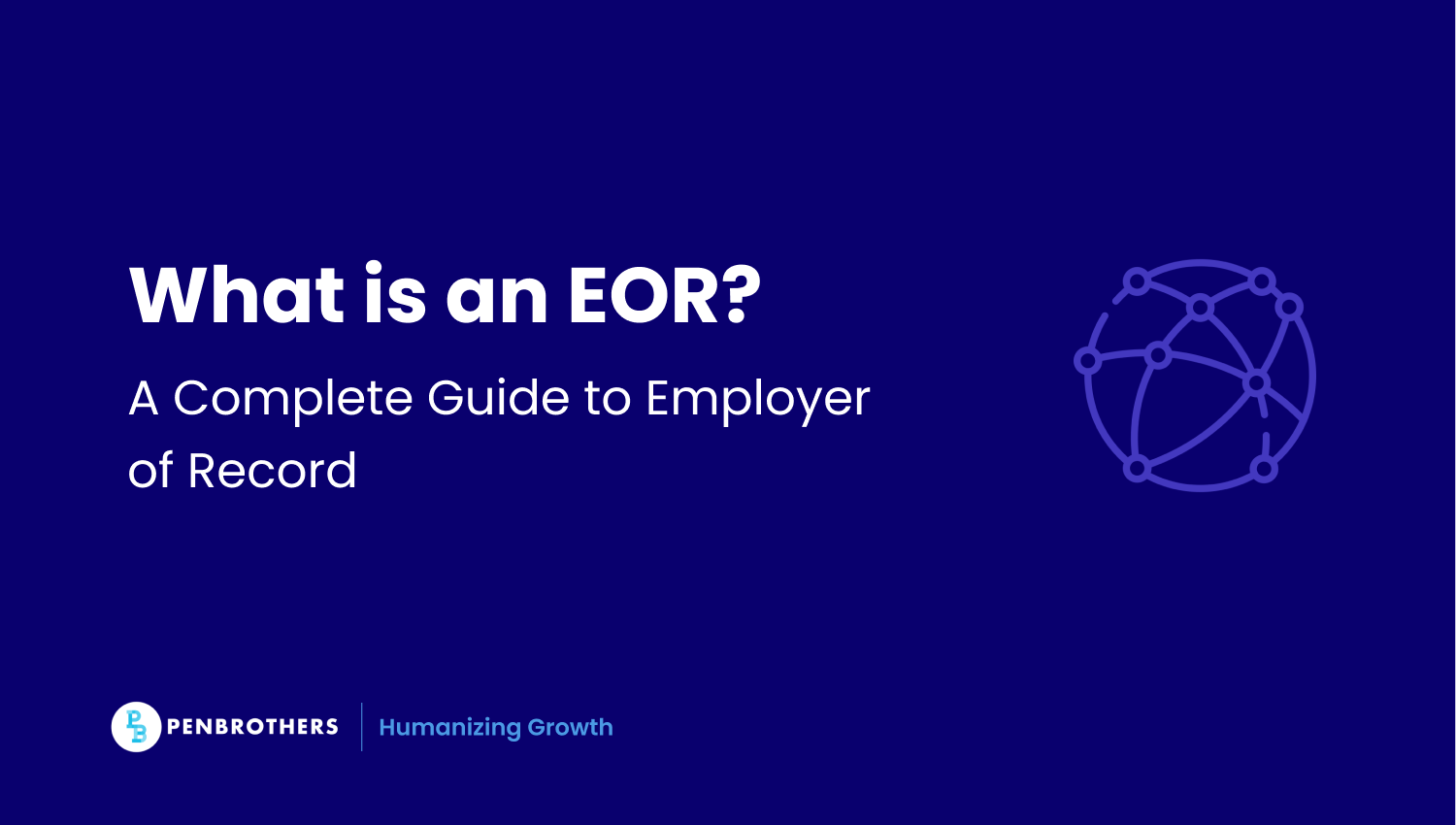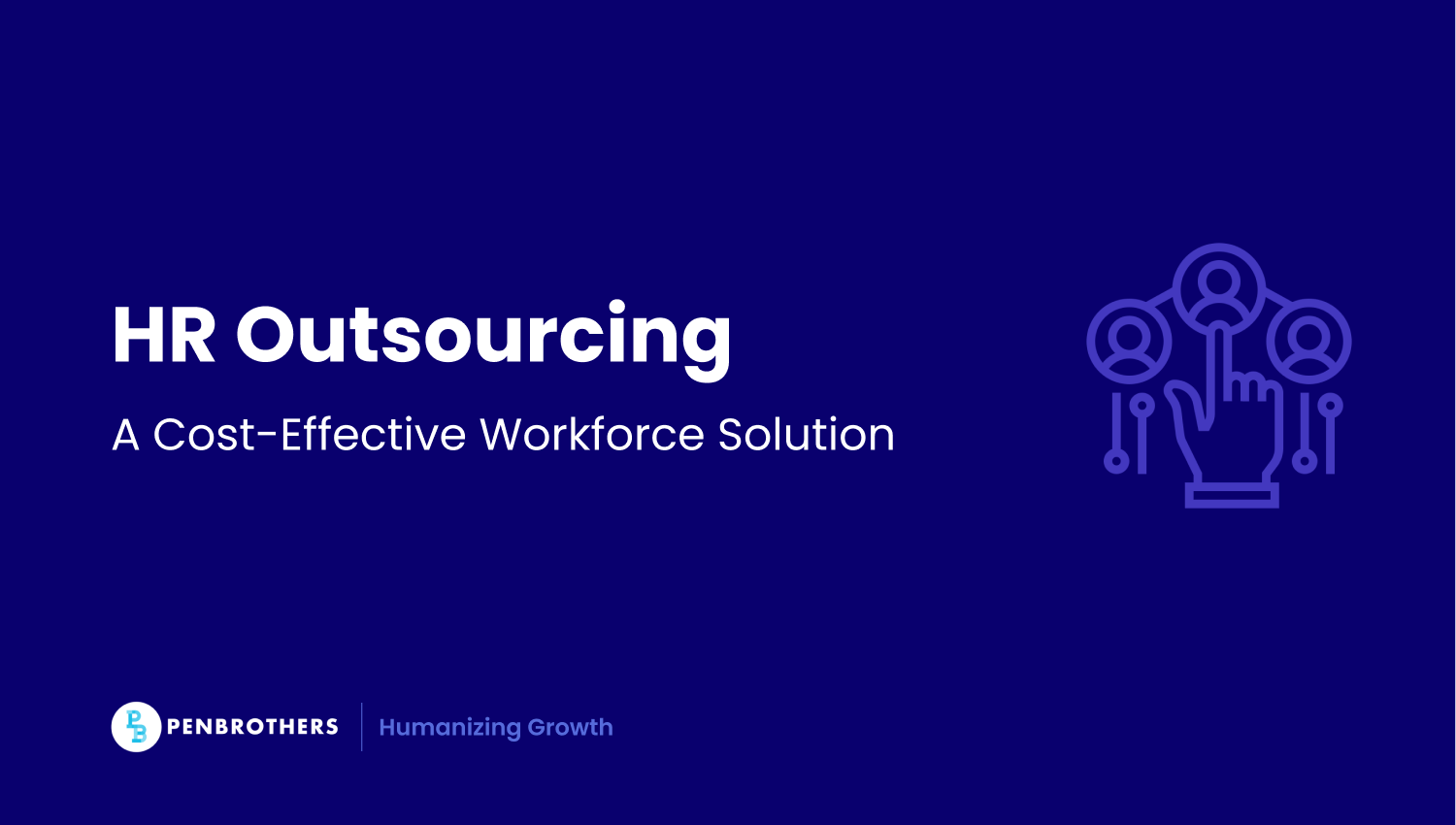What's Inside?
Fed Rate Cuts and Outsourcing in 2025: Executive Guide

The Fed just cut rates for the first time this year. Your CFO is recalculating budgets. Your ops team is revisiting the hiring plan. And somewhere in the back of your mind, you’re wondering: does this change our outsourcing strategy?
It does. But not in the way most people think.
Key Takeaways
- A Defensive Fed Move Signals Economic Uncertainty: The September 2025 Federal Reserve rate cut was not a sign of a strong economy, but rather a defensive measure against a weakening U.S. labor market. For businesses, this signals a period of economic uncertainty where operational flexibility is a top priority.
- Outsourcing Becomes a Strategic Necessity, Not Just a Cost Lever: In this uncertain environment, outsourcing is more critical than ever. It allows companies to convert fixed domestic headcount costs into more flexible variable costs. More importantly, it enables them to use newly available capital to access scarce, high-demand tech talent (like AI and cloud specialists) that is unavailable locally.
- Increased Currency and Trade Risks Require Better Governance: The rate cut introduces new complexities. A potentially weaker U.S. dollar can increase the cost of foreign services, demanding better financial governance and currency risk management in contracts. Simultaneously, the threat of protectionist trade policies, like the proposed HIRE Act, necessitates more resilient, geographically diversified sourcing strategies.
- A “Dual-Track” Outsourcing Strategy is Emerging: Smart companies are adopting a two-pronged approach to outsourcing. They are outsourcing traditional BPO functions (like finance and administration) to gain cost efficiency and flexibility, while also outsourcing high-end technology services to access specialized capabilities and accelerate innovation.
Executive Summary: Why This Matters Now for Outsourcing
The Fed’s September 2025 easing isn’t a victory lap. It’s a defensive move against a weakening labor market, made cautiously as inflation remains above the Fed’s target. The Fed has framed this as an act of “risk management” against a potential downturn, not a broad-based economic stimulus. This is corporate code for “brace for uncertainty.”
Here’s what changed: outsourcing moves from cost lever to strategic necessity. The traditional calculus of cheaper labor overseas now competes with three new realities.
First, a cooling domestic job market makes variable costs more attractive than fixed headcount.
Second, currency volatility demands sophisticated financial management, not just cost comparison.
Third, geopolitical risks require diversified sourcing strategies, not single-hub concentration.
The core insight: smart executives aren’t asking whether to outsource. They’re asking how to outsource strategically in an environment where flexibility beats optimization.
The Fed Rate Decision, at a Glance
What Changed
The Federal Open Market Committee cut rates 25 basis points after months of policy stasis. But this wasn’t about economic strength; it was about job market deterioration forcing their hand.
Why it Happened
Job creation stalled at 22,000 positions in August, well below expectations. The unemployment rate hit 4.3%, the highest in nearly four years. The Fed prioritized employment risk over persistent inflation that remains “somewhat elevated.”
What it Signals
Policy uncertainty, not economic optimism. The dot plot showed deep divisions among officials, with seven out of nineteen projecting no further cuts this year. When the central bank’s own experts disagree this widely, flexible operating models become essential.
How Rate Cuts Rewire Outsourcing ROI
Lower borrowing costs change how companies fund growth, but the real shift is strategic. Corporate IT spending is projected to grow 9.3% in 2025, but it’s not a broad-based investment. It’s targeted strikes at AI, cloud infrastructure, and cybersecurity capabilities.
Here’s where outsourcing becomes critical: the U.S. faces a severe talent shortage in exactly these high-demand fields. Building an AI development team domestically could take months and significant capital. Engaging a specialized global provider? Weeks.
So the Fed’s rate cuts unlock capital, but domestic talent scarcity channels that capital toward strategic outsourcing for high-skill technology services. The calculus has shifted. Companies now outsource to access specialized capabilities that simply don’t exist in sufficient quantity back home.
Meanwhile, margin pressure from tariffs creates the other side of the equation. Companies need traditional BPO to shed fixed costs while investing in innovation. The result: a dual-track approach where the same company might outsource back-office processing for cost savings and AI development for competitive advantage.
Currency Mechanics: Weaker Dollar, Stronger Governance
Rate cuts typically weaken the dollar, and markets reacted accordingly. For outsourcing, this creates a predictable challenge: a U.S. company’s dollars buy less of the local currency, meaning they must spend more to cover service costs priced in Indian Rupees or Philippine Pesos.
But here’s what most miss: a 10% currency swing doesn’t eliminate a 70% cost advantage from outsourcing. It just changes how you manage the arrangement.
The strategic response isn’t to abandon outsourcing, it’s to govern it better. Treasury functions are becoming more sophisticated in managing FX risk through hedging strategies, currency adjustment clauses, and diversified sourcing portfolios.
Practical tools for currency risk:
- Fixed-rate contracts with defined review periods
- Currency adjustment clauses with transparent calculation methods
- Multi-currency sourcing portfolios to smooth volatility
- Forward contracts for predictable cost structures
Budget Impact: IT and BPO Spend Under Easier Policy
Lower capital costs are unlocking previously frozen budgets, but the allocation follows a clear pattern: strategic technology spending gets the green light while operational costs face relentless scrutiny.
The bifurcation is stark. HFS Research notes that rate cuts are boosting sentiment for large-scale technology projects, particularly those involving AI and digital transformation. These initiatives get approved because they promise measurable competitive advantage.
Simultaneously, enterprises are more receptive to BPO for finance, accounting, and administrative functions. The economic uncertainty makes converting fixed overhead into variable costs more attractive, not less.
This creates two distinct markets for service providers. High-end technology partners win strategic projects focused on innovation and capability building. Traditional BPO providers compete on operational excellence and cost efficiency. The middle ground (generic IT services without clear strategic value) gets squeezed.
Policy Crosswinds: Rate Cuts vs. Protectionist Risks
Here’s the paradox: Fed policy makes global sourcing more attractive just as trade policy makes it riskier. The proposed HIRE Act threatens a 25% tax on outsourced services, while similar legislation targets call centers specifically.
Even if these bills don’t become law, they signal political hostility that’s forcing corporate leaders to demand greater flexibility in outsourcing contracts. The response isn’t to avoid outsourcing. It’s to build more resilient sourcing strategies.
Bain research shows 80% of COOs plan to increase nearshoring over the next three years. The response preserves existing offshore relationships while building diversified supply chains that can withstand policy shocks.
Related articles:
- The U.S. Government Shutdown Is a Wake-Up Call for Offshore Resilience
- Trump on IT Outsourcing: HIRE Act Facts, Risks, and Next Steps
- The H-1B Visa $100K Fee: Policy Details and Industry Reactions
- Outsourcing to India and the HIRE Act: What U.S. Companies Should Do Now
- Outsourcing Tax: What Is Official, What Is Proposed, What Is Noise
Where to Build: Comparing Major Hubs at a Glance
The optimal outsourcing strategy in 2025 requires building a portfolio that balances cost, capability, and resilience rather than simply chasing the lowest-cost location.
India remains the dominant player for high-skill technology work. Software developers average $15,000-$25,000 annually, with deep expertise in AI, analytics, and complex development projects. The challenge: 9.5% salary inflation in 2025 and exposure to protectionist legislative proposals in the U.S.
The Philippines dominates contact center services and administrative support, with a certified public accountant (CPA) earning $18,000-$22,800 annually. The risk: political pressure in the U.S., including periodically proposed legislation aimed at discouraging the offshoring of call center jobs.
Mexico and Latin America offer nearshoring advantages with minimal time zone friction and lower political risk. Costs run higher than traditional offshore hubs, but 80% of COOs are increasing nearshoring investment for supply chain resilience.
Key evaluation criteria:
- Sector expertise: Deep talent pools in your industry
- Salary trajectories: Multi-year cost projections, not just current rates
- Currency stability: Historical volatility and projected ranges
- Political risk: Exposure to U.S. trade policy changes
Smart companies are scoring potential hubs against all four factors, then building hybrid models that spread risk while preserving cost advantages. A single corporation might have AI development in India, customer service in the Philippines, and administrative processing in Mexico, each location optimized for its specific function and risk profile.
What to Watch Next
Three signals matter most:
Policy dispersion. Watch for consensus building in Fed communications or continued fragmentation among officials. Wider disagreement means more uncertainty for corporate planning.
Legislative momentum. Track progress on outsourcing-related bills, particularly measures affecting eligibility, reporting, or cost structures.
Dollar trajectory. Monitor currency movements and their impact on service provider pricing. Sustained dollar weakness will force contract renegotiations across the industry.
A Practical Next Step
If you’re re-evaluating your outsourcing strategy in light of Fed policy and market conditions, start with a comprehensive risk assessment across your current portfolio. Map currency exposure, assess geopolitical concentration, and identify capability gaps that strategic partnerships could address.
The goal isn’t to optimize for today’s conditions. The goal is to build resilience for an environment where change is the only constant.
If you want help translating this into a resilient hiring and delivery plan, we can walk you through a structured assessment, the right portfolio mix, and a contract architecture that protects margins while you scale.
Frequently Asked Questions
The Fed cut rates as a “risk management” action in response to a deteriorating U.S. labor market, which had seen stalled job creation and a rising unemployment rate. It was a defensive move to support employment, even while inflation remained above the Fed’s target.
It makes outsourcing more important in two key ways. First, the economic uncertainty it signals encourages businesses to prefer the variable costs of outsourcing over the fixed costs of hiring permanent domestic employees. Second, while lower rates make it cheaper to fund technology projects, the severe shortage of domestic tech talent means companies must outsource to find the specialized skills required for those projects.
Yes, a weaker dollar can increase the cost of services that are priced in foreign currencies. However, it typically does not eliminate the significant overall cost advantage of outsourcing. This currency volatility simply requires companies to implement better financial governance in their contracts, such as using fixed-rate terms, hedging strategies, or currency adjustment clauses.
The HIRE Act is a proposed U.S. bill that would place a 25% tax on many outsourced services. This creates a policy paradox: while the Fed’s monetary policy makes global sourcing more attractive financially, potential protectionist trade policy could make it more expensive and risky.
Companies are moving toward geographically diversified, hybrid models to build resilience. Instead of relying on a single offshore hub, they are creating a portfolio that balances cost, capability, and risk. A common strategy involves using different locations for different functions, such as India for high-skill tech, the Philippines for customer service, and Mexico for nearshoring.




